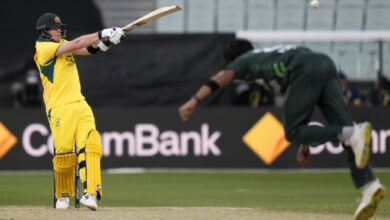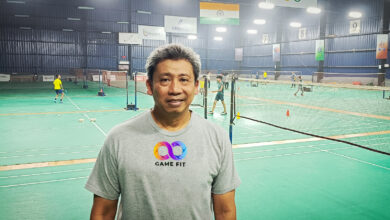Tamil Union, the cradle of Sri Lankan cricket, now a shadow of a glorious past | Cricket News

Dimly-lit surroundings, furniture that date back at least a couple of decades, and the cream-coloured coating on the pillars and walls don’t give away the storied hory of the Tamil Union Cricket and Athletic Club.
Except for an Ilaiyaraaja melody from the 1980s that plays softly in the background, there is no ear-splitting music or noise even from the Oval Taverners bar that sits close to the pavilion. The board at the entrance tells one everything about the club, which was founded in 1899 and happened to be the place where Sri Lanka took its ba- steps in cricket. But whichever side one turns to, there is a vintage feel to it, where one could just close the eyes and picture Don Bradman walking out to play and Sri Lanka tasting their first-ever Test win over India to even the match-winning fourth innings century VVS Laxman in 2010.
For a club that was once the heart and soul of Sri Lankan cricket, it now resembles every bit a forgotten old man, sitting alone, reminiscing the glorious past and the turbulent times it has withstood. After coming into exence after two clubs decided to merge together, it was P Saravanamuttu, after whom the stadium is named, who played an instrumental role in the venue getting international matches.
The club has given Sri Lanka illustrious players such as Tillakaratne Dilshan, Rangana Herath, Suranga Lakmal and Upul Chandana.
Photos taken at Tamil Union Cricket and Athletic Club which is at P Saravanamuttu Stadium, Colombo. (Picture credits: Venkata Krishna B)
“It was a marshland when we bought this land and Saravanamuttu took the challenge and built a beautiful ground and called it the Colombo Oval. With people thronging to watch cricket, he then built the stadium as well as it provided shelter and for a long time, happened to be the only ground in Sri Lanka that had any sort of stadium,” Chandra Schaffter, a former first-class cricketer and ex-president of Tamil Union, tells The Indian Express.
Soon, Vijay Merchant would bring a team from Mumbai to play a few matches at the Oval, where Mahadevan Sathasivam, one of the early greats from the island, scored a century. And the late 1930s, the Colombo Oval would become a pit stop for England and Australian teams whenever they embarked on an Ashes journey. “Every time the English travelled to Australia, they would have a stopover in Colombo. They will arrive in the morning, play a match during the day and go back to the ship at night. I played the 1954 match. Same with Australians, they would stop over and do the same. Every two years, we had a half-day or a one-day match,” Schaftter recalls.
Although Don Bradman didn’t play during his two visits to Colombo after being hit wicket for the only time in his career here in 1930, Schaftter remembers a tale from the 1948 trip. “The Don came back during the lunch break and said the pitch is two yards short. Lot of them didn’t believe it but he made us measure it and turned out, he was actually right. One of the groundstaff had got the measurement wrong and we changed it instantly,” Schaftter says.
Don Bradman’s photo taken at Tamil Union Cricket and Athletic Club which is at P Saravanamuttu Stadium, Colombo. (Picture credits: Venkata Krishna B)
Troubled times
Having established itself as a synonym for cricket in the island, in the 1950s, because of its affiliation with the Tamils, it would run into trouble in the early years of ethnic war. In 1958, it lost one of the matches against England to the Sinhalese Sports Club (SSC). “We had riots that year and they took the game away from us. But with the facilities being limited and no stadium in place, they came back soon after and it remained the home till the Khettarama (RPS) came around in 1986,” he says.
It was the decade when the stadium, now renamed P Saravanamuttu Oval, would run into several problems. According to Schaftter, the civil war and the emergence of the LTTE meant the club would see matches being moved at the eleventh hour to the SSC or RPS. And if that was not enough, in the 1983 riots, the club was burnt down, with all the records going up in smoke.Most Read
1
Jawan box office collection Day 6: Shah Rukh Khan’s film to soon cross Rs 600 cr mark worldwide
2
Deepika Padukone noticed Ridhi Dogra was sitting separately on set, so she moved her seat closer to hers: Jawan actor recalls kind gesture
See More
“It was the most challenging time that all of us went through. The riots ravaged the club and nobody thought we could rise again. Nobody came for help and we understood that all of us (club members) had to fund ourselves and get the ground ready. It took us three-four years to get back on track, but even then we ensured that the stadium kept hosting matches against Australia and India,” Schaftter adds.
And in the same period with Gamini Dissanayake, the former president of Sri Lanka, taking over as chairman of the Sri Lankan Cricket Board, the club would bring about a huge change. From featuring only Tamil players in the team, it opened the doors to all communities, making it an inclusive one.
“Those days, unless you were a Tamil, you couldn’t play for Tamil Union. Same with SSC, where only Sinhalese were allowed to play. But Dissanayake wanted to change this and end the discrimination. It was a good decision and though members were reluctant, all of us came on board. And today, there is not a single Tamil player playing for us,” Schaffter says.







